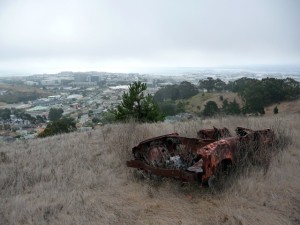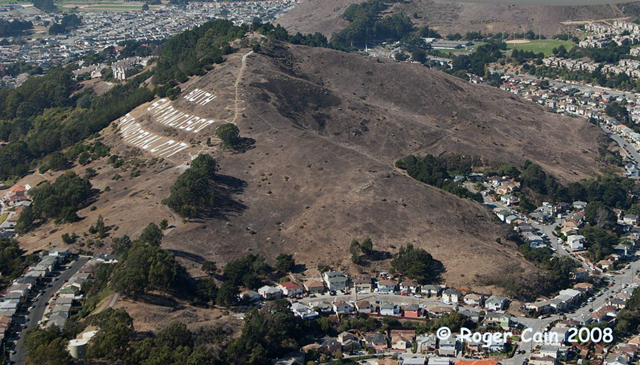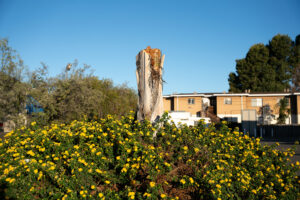South San Francisco may be “THE INDUSTRIAL CITY,” as stated on the hillside overlooking the town of warehouses and industrial parks on the outskirts of SFO.
But nestled alongside Sign Hill Park, which hosts the moniker, is a patch of land that’s remarkably wild for its location and among the last of its kind in the Bay Area.
The nearly 46 acres of privately-owned, healthy grassland are a rare spectacle, home to the endangered Mission blue and San Francisco callippe silverspot butterflies, as well as other insects, reptiles, and up to 15 native plants. A network of conservationists, stewards and local residents are ramping up their efforts to keep it that way.

“You have this incredible piece of wild nature amid the modern construction of man,” says David Schooley, founder of San Bruno Mountain Watch (SBMW). “This is the last intact remnant of California’s Franciscan bioregion, and the people deserve to experience it.”
For decades, preservationists have fought high-profile battles to preserve neighboring San Bruno Mountain. Now, a recently formed “Save Sign Hill” campaign, led by non-profits SBMW and Friends of Sign Hill, is striking a higher profile as its own unique cause.
Untapped Potential
Sign Hill Park itself is publicly owned and accessible, but it’s the facade to the virgin grassland that lies just behind it. Preservationists say the land has never been used for cultivation or grazing. Fearing future development on the hidden gem, the group is trying to raise enough money to purchase the land — collectively valued at more than $1 million — or convince the existing owners to devote it to open space.
That may be a tough sell at a time of booming Bay Area real estate values. The land consists of three parcels, and the owner of the largest of them, a 20-acre plot on the eastern edge, intends to build a housing complex under city zoning requirements of one house per acre, clustered around cul-de-sacs. Sullivan Land Development, based in San Jose, hasn’t submitted plans yet, but the company and property owner John Nicholson are talking about it.
“Of the 20 acres, about six to seven acres would be affected,” says John Ward, a consultant working with the Sullivan group. “The remainder would be allocated to open space.”
The other two parcels are jointly owned by Syme Venture Property and Robert Casey Revocable Trust, based in Burlingame, and include hillsides too steep to easily develop.
Ward says the plans, when submitted, would strike a balance between development and conservation.
“Dedicating all of the land to open space is not economically feasible,” says Ward. “But we had a meeting of the minds with the people looking to preserve it, and the goal is to find a common ground and ultimately dedicate a substantial portion to open space.”
The Save Sign Hill advocates give kudos to the Sullivan group for at least talking about conservation. But they want the land to remain fully intact.
“It may look small, only 20 acres, but what you are seeing is fragmentation of a habitat,” says Ken McIntire, executive director of SBMW. “Habitat conservation plans don’t always fix the problem. It’s basically a way to allow building construction whittle away at nature.”
Building Support
The Save Sign Hill advocates are drumming up community support through social media, leafleting, door-to-door visits and connecting with neighborhood advocacy groups. The more people who understand what is going on behind the famous sign, the better, they say.

A strategy meeting in July drew out about 50 attendees, including members of the South San Francisco city council and the parks and recreation department. The group believes if it can get ahead of the game, before the Sullivan group submits development plans, it will be better off.
“What we are trying to do is be proactive,” says McIntire. “We’ve had a lot of involvement with lawsuits in the past, and that’s not what we are trying to get into.”
In the late 1980s and 90s, the organization managed to stall developments on San Bruno Mountain to protect the Callippe silverspot butterfly, but ultimately were unable to preserve as much of the area as they had wanted. SBMW lost a 2009 lawsuit against San Mateo County.
Initially, the group considered similar tactics to preserve the area behind Sign Hill. In the early 2000s, when a different developer sought out the land, SBMW commissioned a biological assessment of the property and found potential nectar source for the Mission blue butterfly. That meant developing the land would likely require a federally-approved habitat conservation plan.
But McIntire says the new strategy to preserving the land is to convince the owners and public of its value, not invoking the state’s landmark environmental protection law, the California Environmental Quality Act (CEQA).
“Our goal is not to have a CEQA fight,” says McIntire, “But to instead find a way to get those acres purchased, or get the existing owners to dedicate them to public use.”
The Save Sign Hill advocates are gathering supporters from other conservation groups, scientists and government officials onto a preservation committee that will come up with a plan to purchase the land. Following the July meeting, a presentation at the August 22nd city council meeting was the next step towards solidifying the movement.
“We hope to have things more finalized by October,” says Kamala Silva-Wolfe of Friends of Sign Hill. “Right now, it’s about lining up the groups, putting the wording together and figuring out a sales pitch, of sorts.”
For the most part, the community has been supportive of the campaign.
“We don’t want to sit and wait for something to happen to it, “ says Loretta Brooks, a local resident who tends native plants on Sign Hill Park. “This is all about keeping this last vestige of wilderness in a dense urban area.”
The Need for Stewardship
The area is not open to the public, but ridge trails surrounding it offer an impressive view into the grassland. Development is not the only threat to the grassland. Non-native invasive plants are ever present, and to keep them from encroaching on the area, advocates regularly lead educational hikes and host weeding and native plant rehabilitation outings. Youth serving juvenile detention go there as gardeners to fulfill community work requirements.
“We bring people out here and try to help them understand how important it is to preserve this,” says Schooley. “In turn, they get to experience the benefit of being out in nature.”

On a recent hike to the area, it was clear why the land has sparked such passion. Huge swaths of hummingbird sage –possibly the largest distribution of it in California – cover western-facing slopes. Coast rock cress, a rare manzanita found only on San Bruno Mountain ridges, and silver lupine, the main feeding plant of larval Mission Blue butterflies, pop up where they can in a fight against the aggressive non-native invasive plants like Italian thistle, mustard, radish and fennel.
The land needs special designation as rare habitat to ensure protection, say the preservation advocates.
While the Mission Blue butterfly is a protected species –and the official butterfly of South San Francisco – the plants that provide it food and shelter are not. Prior development in the area was done with the butterfly in mind, but disregard for the host plants destroyed critical flight corridors.
“You can’t protect one thing while ignoring another,” said Schooley. “When you kill the plants that make up its home, you might as well kill the butterfly.”
Mission Blue eggs were found last May in this area, but the butterflies themselves remain elusive. Along with endangered butterflies, 30 species of native ants inhabit Sign Hill and San Bruno Mountain. If non-native plants are not removed, these habitats will slowly vanish.
Buying the land will likely require multiple agencies and donors. The 20-acre plot has been valued at more than $850,000, and the other two plots at upwards of $130,000 apiece. That’s too much for the cash-strapped city of South San Francisco to purchase outright, says South San Francisco councilmember Karyl Matsumoto.
“We don’t have the kind of capital to purchase the land,” said Matsumoto. “If we did, I would say, hands-down, that would be the case. Nobody wants to see open space go away and we completely support the efforts to save it, but it really comes down to money.”
Nevertheless, the Save Sign Hill campaign hopes to tap potential donors from some unusual places — Kaiser-Permanente health care, for example.
“Anyone who is interested in preserving open space and contributing to people’s health and well-being is a potential donor,” says Matsumoto.
A key challenge will be convincing the public, and donors of the urgency. The lack of concrete development plans means it’s hard to pinpoint when the opportunity to save the land has passed.





